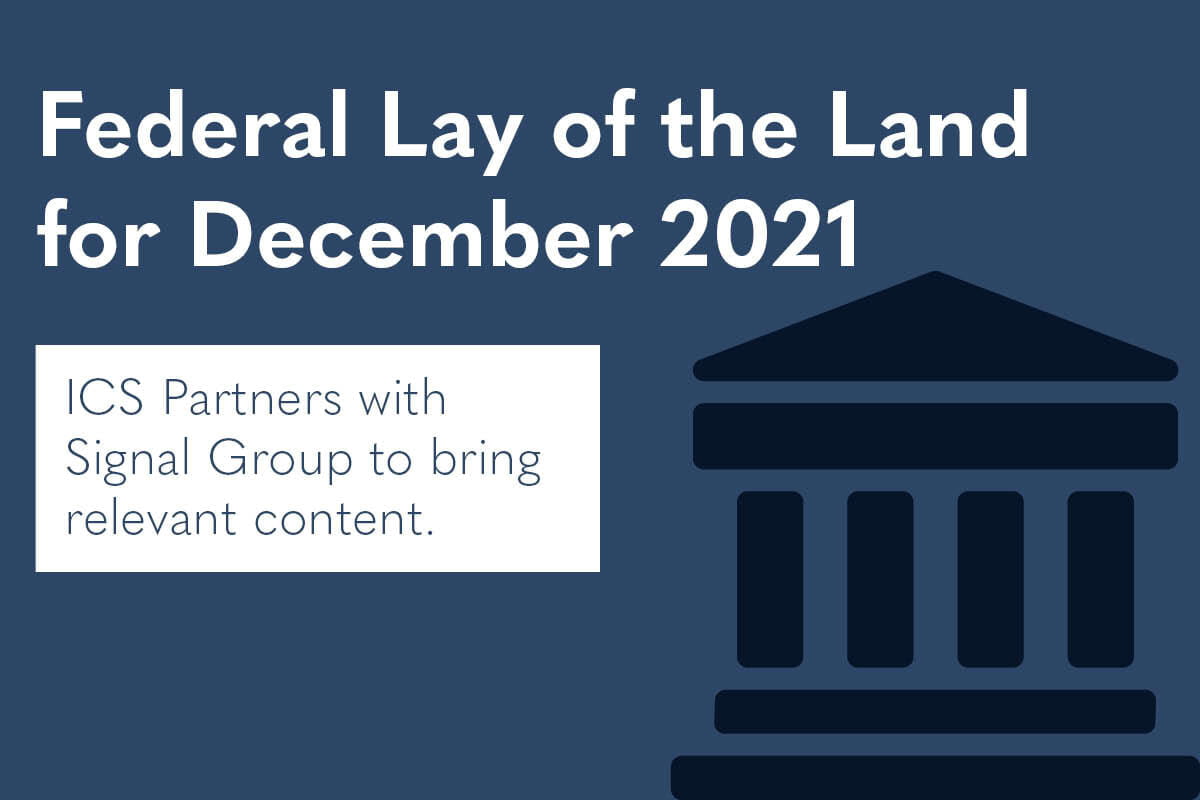In collaboration with Signal Group, here’s the Federal Lay of the Land for December 2021. For more information, please reach out to Dave Bergeron at dave.bergeron@ics-builds.com.
Economic Markers
Gross Domestic Product
The latest data from the Bureau of Economic Analysis estimates that U.S. GDP grew at an annual rate of 2.1% in the third quarter of 2021, according to the second estimate. This growth rate is far lower than that of second quarter real GDP, which increased at a rate of 6.7%. This month’s estimate is based on more complete source data than was available for the advance estimate last month.
BEA will release its third estimate for the third quarter, based on more complete data, on December 22, 2021.
Employment
According to data from the Bureau of Labor Statistics, the unemployment rate decreased by 0.4% in November, falling from 4.6% to 4.2%. The number of unemployed persons edged down by roughly 542,000 to 6.9 million. While unemployment is improving, rates remain elevated from their pre-COVID levels of 3.5% and 5.7 million. Notable employment gains occurred in the following sectors: professional and business services, transportation and warehousing, construction, and manufacturing. Retail trade employment declined in November.
Employment in manufacturing increased by 31,000 in November with fabricated metal products seeing 8,000 new jobs and durable goods manufacturing seeing 10,000 new jobs. Motor vehicles and parts lost 10,000 jobs in November.
Construction employment also grew by 31,000 in November with specialty trade contractors seeing 13,000 news jobs and construction of buildings seeing 10,000 new jobs.
Both manufacturing and construction jobs remain significantly lower than their February 2020 levels, with manufacturing down by 253,000 and construction down by 115,000.
BLS will release the Employment Situation for November on January 7, 2022.
Inflation
According to the Bureau of Labor Statistics’ latest Consumer Price Index (CPI) data released on November 10, price levels rose 0.8% (seasonally adjusted) between October and November and are up 6.8% (before seasonal adjustment) compared to November 2020. This is the largest 12-month increase since June 1982. Over the last 12 months, energy rose 33.3% and food rose 6.1%.
BLS will release December’s CPI numbers on January 12, 2022.
Prices for steel have dropped slightly from October to November (seasonally adjusted) from 4.1% to 2.4%. Year over year, prices for steel have risen 141.6%.
Prices for wood and lumber products have risen by 4.3% between October and November. Year over year, lumber prices have increased 13.3%.
The Federal Reserve’s latest response to inflation is to (1) end bond purchases by March 2022, and (2) increase interest rates three quarter percentage-points by the end of 2022. Additionally, Fed Chair Jerome Powell stated with rising prices and wages alongside upticks in the job market, further policy support is not needed to spur our economic recovery from the pandemic.
The Federal Reserve does not believe the emerging Omicron variant of COVID-19 will cause additional flare-ups to price levels. The Fed forecasts that economic conditions will continue to improve with inflation easing on its own, a slow increase of interest rates, and maintenance of low unemployment rates. However, some economists are skeptical of this prediction.
Infrastructure Legislation
Infrastructure Investment and Jobs Act
The Infrastructure Investment and Jobs Act (IIJA) was signed into law on November 15 and some initial buckets of funding are beginning to be disbursed.
The timing and flow of the package’s funding will vary significantly by agency and by program. IIJA funds that go towards existing programs will likely roll out much quicker than funding for newly created programs in the legislation. For new programs, agencies must hire additional staff, develop criteria for grant selections, and draft implementation guidance documents.
Build Back Better Act
The Build Back Better Act (BBB) passed out of the House of Representatives on November 19, however the likelihood and potential timeline for full passage of the legislation remains unclear.
Sen. Manchin on BBB. On December 19, Sen. Joe Manchin (D-WV) appeared on Fox News and said of BBB, “I cannot vote to continue with this piece of legislation. I just can’t. I’ve tried everything humanly possible. I can’t get there.”
According to reporting by CNN, President Joe Biden had become pessimistic that he could get Sen. Manchin on board with voting for BBB. However, White House officials were not expecting Manchin to announce his “final” decision so soon during his Sunday Fox News appearance.
Some of Sen. Manchin’s key sticking points have been paid family leave, Medicare expansions, a methane fee on emissions from energy producers, and various tax provisions. Manchin has also been vocal about his concerns over the impact of BBB on both inflation and the national debt.
Is BBB over? Not necessarily. All of this media buzz does not necessarily mean that BBB is over. Machin’s statement was largely spun by the press and stakeholders as the final death knell for the bill. Manchin was responding to the question “today, right now, what is the state of play?” It was already abundantly clear that he was a no vote on the bill in its current form, so his Fox News appearance does not necessarily indicate his unwillingness to consider the legislation if further changes are made to it.
In response to Manchin’s press activity, Senate Majority Leader Chuck Schumer (D-NY) released a “Dear Colleague” letter on December 20. In it, Schumer outlined his goal that the Senate hold a BBB vote “very early in the new year” and asserted that the Senate will “keep voting on it until we get something done.”
Next Steps
With the IIJA signed into law and the BBB passed out of the House, Congress and the Administration will begin the new year focused on moving the needle on at least some portions of the BBB and orchestrating a successful rollout of the IIJA.

